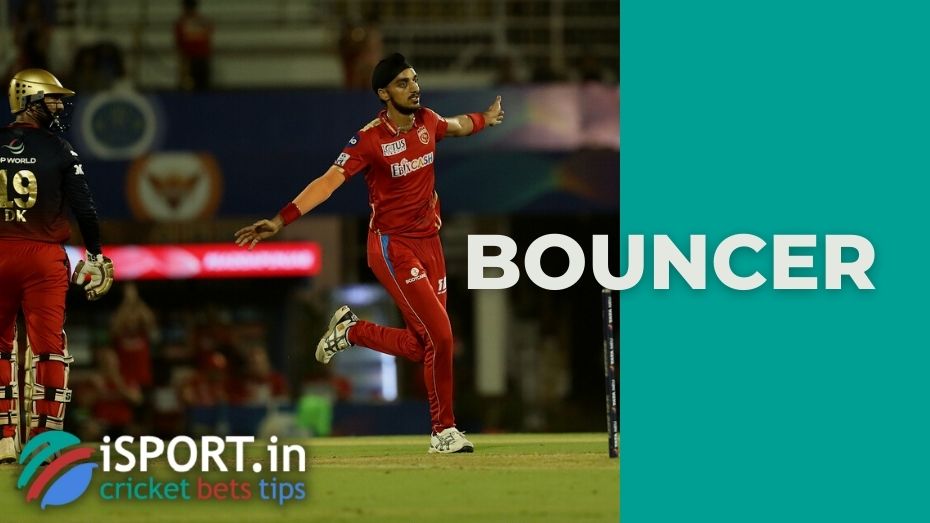Bouncer

There are various kinds of deliveries in cricket, and most of these are mastered by top-level players. The bouncer delivery is regarded as a sign of superior skill. Fast bowlers usually make this throw. After being bowled, the ball bounces once on the pitch and rises to head height as it reaches the batsman.
Bouncer: Definition and Distinction
There are cases when bouncer execution turns out to be useful for the batsman. The kick that the kicking players perform in such a situation is called a hook shot. To make such a blow, you need to stand in the off side and move the back foot backward. When the batsman sees that the bowler has completed the throw, he needs to move to the back foot, keeping the bat horizontal. The kicking player aims to hit into or over the leg side boundary. When performing each element of this technique, you need to be very careful since any incorrect movements can lead to the fall of the gate.
It is important to distinguish between a bouncer and a beamer, as they are fundamentally different types of cricket deliveries. A bouncer is characterized by the ball bouncing off the pitch before reaching the batsman, while a beamer is a delivery that reaches the batsman without bouncing, which is currently prohibited.
A delivery is usually deemed legal under two circumstances:
- The ball bounces off the pitch while targeting the batsman’s body.
- Once pitched, the ball stays below the waist of the batsman.
Deliveries that fail to meet these criteria may be classified as illegal. In the game of cricket, bouncers are frequently employed as a strategy to put the batsman “on the back foot“. This phrase suggests that the batsman, who was previously exhibiting confidence by playing forward strokes, is now forced to adjust their stance.
At the same time, a bouncer option is available for the batsman to play both as a defender and attacker. In defense, a batsman usually has two goals:
- Not to get out.
- Not to get hit.
Experts advise moving the head to the side to evade the ball safely. Sometimes, a batsman spots the ball at chest level and chooses to play it down the field to prevent fielders from catching it. This requires shifting weight to the back foot, raising the bat vertically to chest level, and playing a controlled shot. In certain situations, even batsmen have to jump to tackle the ball. Bowlers also use the bouncer as a way to unnerve or mislead the batsman.
When the Bouncer Benefits the Batsman
Occasionally, a well-executed bouncer can create an opportunity for the batsman to launch a counter-offensive through a hook shot. To perform this maneuver, the batsman positions themselves on the off side, shifts their back foot, and prepares to strike the ball with a bat held horizontally. The goal is to direct the ball either into or beyond the boundary on the leg side. Accuracy is essential, as any error in technique may result in being dismissed.
Bouncer Rules in Cricket
The Laws of Cricket outline specific regulations governing the use of the bouncer, including how many fielders may be positioned behind square on the leg side and how often a bouncer may be bowled in an over.
In 1991, the International Cricket Council (ICC) implemented a rule allowing only one bouncer per batsman per over, following decades of controversy – largely as a result of hostile employment by the likes of the West Indies during the 1970s and 1980s. The tactic, initially deployed by England in the 1932-33 Ashes campaign against Australia, was termed Bodyline and attracted strong criticism.
Not everyone welcomed the 1991 restriction. English umpire Dickie Bird thought umpires should control bouncers at their discretion. His case gained support, and in 1994 the ICC amended the rule, permitting two bouncers per over. Offences incurred a two-run no-ball penalty (formerly one run).
In One Day Internationals (ODIs), bouncer rules changed:
- Since 2001: One bouncer per over permitted, with a one-run no-ball penalty for offences.
- Since 2012: The International Cricket Council has allowed the use of two bouncers.
Bouncer-Related Injuries and Deaths
Though most players bounce back from bouncer-related episodes and come back stronger, there have been some severe injuries as well:
- In 1954, England’s Frank Tyson bowled bouncers at Australia’s Ray Lindwall. In response, Lindwall delivered a brutal ball that sent Tyson to the hospital. Tyson came back the next day and assisted in winning the match.
- In 1994, Fanie de Villiers (South Africa) hit Devon Malcolm (West India) in the head with a bouncer. Even though, Devon decided to continue the game and and score 57 runs.
Unfortunately, there are episodes in the history of cricket when cricketers received more serious injuries after performing bouncer:
- In 1962, India’s Nari Contractor was struck by a bouncer from West Indies’ Charlie Griffith. He was unconscious for nine days and took nine months to recover.
- In 2006, South African Makhaya Ntini sent Australia’s Justin Langer to the hospital.
- In 2008, Australian Brett Lee knocked out West Indian Shivnarine Chanderpaul and returned to play an hour later.
- In 2014, Australian Phillip Hughes was hit in the neck by a bouncer from Sean Abbott. The ball slipped between his helmet grille and shell, leading to a brain hemorrhage. Hughes passed away two days later.
- During the 2019 World Cup semifinal, England’s Jofra Archer bowled a bouncer that knocked off Alex Carey’s helmet. Carey responded well and avoided injury.
- Later that year, in The Ashes, Archer bowled a bouncer to Steve Smith, who was taken off the field with a concussion – although he returned to play 45 minutes later. The decision drew criticism from the brain injury charity Headway.
In response to these incidents, especially those in 2019, the ICC started reassessing bouncer-related rules again.
